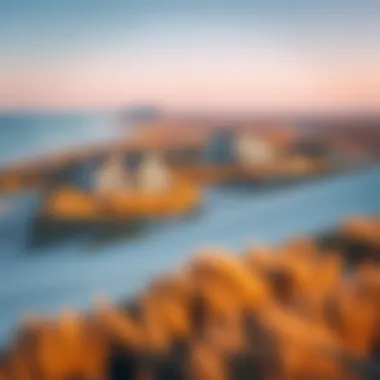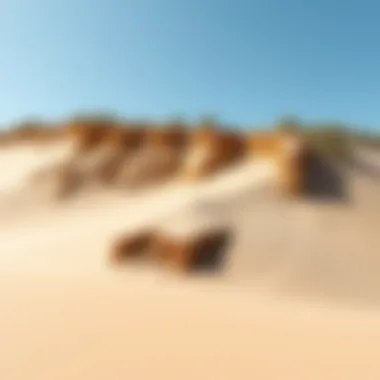Dune Properties: Coastal Landforms and Their Impact


Intro
Coastal landforms, particularly dune properties, present unique ecological and geological spaces that hold significant implications for investors and homeowners alike. The interplay between natural beauty and real estate potential creates a complex narrative that begs closer examination. Dunes are not mere hills of sand; they represent dynamic systems that shape environments, influence coastal ecosystems, and ultimately serve as foundational aspects of real estate in coastal settings.
Understanding dune properties requires delving into their formation, types, and relevance in the overarching landscape of property market trends. This introductory section paves the way for a deeper exploration of the ecological advantages and challenges posed by dunes. The integration of these natural features into residential life speaks volumes about the balance between preservation and development, setting the stage for what comes next. Throughout this article, we’ll navigate through intriguing facets of dune properties, underscoring their investment potential and the economic swings governing the coastal market.
As we embark on this journey into the unique attributes of coastal dunes, it is essential to grasp how these natural formations influence our living spaces and investment opportunities. With this foundational understanding, let’s dive into the current market trends influencing dune properties.
Prelude to Dune Properties
Dune properties represent a unique convergence of natural phenomena and human interest, where the dynamic interplay between land and sea creates captivating geographical features. These coastal landforms are not only a sight to behold, they also play a vital role in shaping local ecosystems and influencing property values in coastal regions. As residents and investors increasingly set their sights on these vibrant areas, understanding the characteristics of dune properties becomes paramount.
Defining Dune Properties
Dune properties consist primarily of sand hills formed by wind action, often seen lining coastlines or inland areas subjected to consistent breezes. These structures can vary significantly in shape, size, and complexity, which adds an engaging diversity to the landscape. From the gentle slopes of parabolic dunes to the distinct crescent shapes of barchan dunes, each type of dune provides a glimpse into the forces of nature that crafted them.
When discussing dune properties, it is essential to consider their geological composition. Often, the sand that composes these formations is derived from eroded rock particles, fine clay, and silt, thus reflecting the regional geology. The presence of vegetation, such as grasses and shrubs, also plays a key role in defining dune characteristics. By trapping sand and stabilizing the slope, flora helps prevent erosion, thus enhancing the ecological integrity of the area.
"Coastal dunes serve as natural barriers against storm surges, providing essential protection to inland communities."
Importance of Dunes in Coastal Ecosystems
Dunes contribute significantly to coastal ecosystems, offering habitat and sustenance to a variety of flora and fauna. They act as protective buffers against the ocean’s relentless power, safeguarding delicate coastal areas from erosion and providing a rich habitat for wildlife. Migratory birds often depend on dune landscapes for nesting, while various plant species rely on the shifting sands for growth.
Moreover, dune ecosystems can filter pollutants from groundwater, promoting healthier local water systems. The vegetation in these regions not only helps anchor the sand but can also create microclimates that support diverse species that might not thrive in more exposed areas. In essence, dunes are much more than mere sand heaps; they form critical links in the ecological chain of coastal environments.
Understanding the extensive role that dunes play enables investors, environmentalists, and developers to make more informed decisions about land use and conservation strategies. As coastal communities face mounting pressures from climate change, recognizing the multifaceted importance of these landforms can guide responsible stewardship and sustainable development.
Types of Dunes
Dunes are more than just large piles of sand; they represent a dynamic interplay between nature and geography. Understanding the various types of dunes is crucial for appreciating their ecological importance, their role in coastal landforms, and the real estate potential they may hold. Each dune type has distinct characteristics formed through different wind patterns, vegetation cover, and environmental conditions. For investors and buyers interested in coastal properties, knowing about these types can be the difference between a wise investment and a misplaced resource.
Parabolic Dunes
Parabolic dunes resemble the shape of a U or in some cases an open palm. They typically form in regions with abundant vegetation that stabilizes the sand. Over time, the wind shapes them into their characteristic form, with points that face downwind while the arms rest on the ground. These dunes are not just scenic; they play an essential role in sand retention, often creating a protective barrier that shields inland areas from other environmental stressors, such as erosion or flooding.
But there’s more to it. For landowners, the stability of parabolic dunes offers a unique opportunity for developing properties. Building behind these natural barriers can reduce the risk from harsh sea weather. Furthermore, these areas can develop into rich ecosystems, providing a fascinating perspective for environmental investors who understand the value of biodiversity.
Barchan Dunes
Barchan dunes owe their name to their crescent shape, with tips pointing in the direction of the prevailing wind. They usually form in arid regions where sand supply is limited. This dune type can migrate across surfaces, impacting settlements and habitats in their path. As an investor, this movement must be considered; properties close to theseDynamic dunes might quickly find themselves in different locations than initially anticipated.
They serve another purpose as well, attracting attention because of their dramatic shifts in form, providing an always-changing landscape. For buyers, barchan dunes can be both charming and challenging. The key is to choose carefully where to invest in these shifting sands, ensuring that the property boundaries accounting for their movement can sustain long-term value.
Transverse Dunes
Transverse dunes are essentially the converse of barchan dunes. Instead of being crescent-shaped and migrating along the wind's path, these dunes run parallel and rise vertically, resembling waves frozen in time. Forming in areas with abundant sand supply and consistent wind, they can create stunning landscapes. Their long, linear formations can serve as natural corridors for wildlife and offer breathtaking views for potential homeowners.


For developers, these features are a double-edged sword. Though they provide beautiful scenery, the challenge lies in the potential for sand shifts and erosion, which might threaten properties over time. Investors must prudently assess whether the beauty of a transverse dune outweighs the realities of maintaining a sustainable property amidst possible adverse wind and weather conditions.
Linear Dunes
Linear dunes stretch like ribbons across the landscape, distinguished by their elongated form, typically aligned parallel to wind direction. Unlike the barchans and transverse dunes, which arise significantly from one side to the other, linear dunes may form where two wind patterns meet. Clarifying this type of dune may provide insights into investment possibilities, as they tend to stretch over large expanses and can exist in clusters.
For homeowners, linear dunes can create a unique sense of place. They serve as natural barriers for coastal homes while offering a unique aesthetic footprint. However, the challenge remains: sustaining property value, especially in the shadow of potential erosion and access limitations. An in-depth understanding of these dunes is vital for making sound real estate investments.
"Understanding the types of dunes helps in the careful planning and sustainable development of coastal land, ensuring that both ecology and economy are preserved."
The world of dunes is complex and multifaceted. Each type provides unique advantages and challenges for development and conservation. By understanding their key features, investors and homeowners can navigate the unpredictable coastal terrain with more confidence.
Formation and Evolution of Dunes
The topic of dune formation and evolution plays a critical role in understanding the larger narrative of coastal ecosystems. Dunes serve not only as striking natural landscapes but also as protective barriers against coastal erosion, a habitat for countless species, and even a substantial consideration in real estate ventures. Knowing how these intricate landforms come to be and how they evolve over time opens a window into coastal dynamics that can underpin investment decisions and conservation strategies alike.
Wind Patterns and Dune Formation
Wind is the primary architect of dunes. The interplay between wind speed, the direction of gusts, and the availability of sand are all key components in the formation process. In areas where the landscape is dominated by loose sand, subtleties in wind patterns create a variety of dune shapes and sizes. For instance, a dominating wind blowing consistently from one direction might lead to the smooth profile of a crescent-shaped barchan dune, while more erratic winds can yield the elongated linear dunes.
Moreover, understanding local wind patterns is vital for property development in these areas. Builders often face delays or increased costs if they do not account for shifting sand and potential dune migration. This makes it crucial for potential investors and developers to grasp how wind influences dune characteristics and to incorporate this knowledge into planning and construction efforts.
Vegetation Influence on Dune Stability
The presence of vegetation has a profound impact on the stability of dunes. Plants such as sea oats and beach grass not only decorate these landscapes but also cement the sand in place, making it less prone to erosion. Their root systems are remarkable, often extending deep into the sandy substrate, binding the grains together and forming a natural buffer against wind and water forces.
However, not all vegetation is created equal when it comes to dune stability. Some plants might flourish but fail to provide adequate support, while others might thrive in the harsh coastal environment, enhancing the resilience of the dune structure.
In coastal real estate, the role of vegetation can’t be underestimated. Properties with healthy, stable dunes often command higher market values due to their lower susceptibility to erosion and flooding. Investors should also consider local ecological guidelines when planning developments, as preserving native plant species can contribute to both environmental sustainability and property value retention.
Vegetation not only beautifies the landscape but serves as the unsung hero in maintaining dune integrity, emphasizing the need for a balanced approach to development and conservation.
The points detailed here reflect a dynamic understanding of the factors contributing to dune formation and stability, critical for making informed decisions in property acquisition and land management. Recognizing the connection between natural processes and human activity is essential not only for sustainable development but for promoting resilience in coastal communities.
Real Estate Considerations of Dune Properties
Navigating the landscape of dune properties involves a crucial understanding of their unique dynamics. These coastal landforms offer not only picturesque views and recreational opportunities but also present complex challenges for real estate investment and development. As coastal zones continue to be prime targets for development, recognizing the specific elements tied to dune properties is essential for potential investors, agents, and buyers alike.
Investment Opportunities in Coastal Dune Areas
Investors take note: coastal dune areas can serve as prime real estate, often due to their aesthetic appeal and unique ecosystems. Coastal dunes often attract buyers who value scenic views and proximity to the beach, positioning them as high-demand areas in real estate markets. Notably, these properties can serve various purposes, from residential homes to vacation rentals, which can significantly boost their investment potential.
Moreover, the increasing interest in eco-tourism and the green building movement has propelled the appeal of these areas. Developments that harmoniously blend with the natural surroundings can yield lucrative returns. Consideration should be given to properties that not only capitalize on the natural beauty but also integrate sustainable practices that preserve the delicate dune ecosystems.
Challenges in Building on Dune Properties
Building on coastal dunes is not without its challenges.
Regulatory Restrictions


The legal landscape surrounding dune properties is characterized by stringent regulatory restrictions aimed at preserving these fragile ecosystems. Local, state, and federal regulations often dictate what can be built and how it can be developed. Important limits on construction height, land use, and development types are common in these areas.
These regulations are in place to protect both the environment and property owners from issues like increased erosion or habitat destruction. While they may be seen as drawbacks by some property developers, abiding by these restrictions can result in the long-term sustainability of the investment. Ultimately, understanding and navigating these laws is a necessary hurdle for any aspiring real estate developer in these regions.
Erosion and Weathering Issues
Erosion and weathering present another layer of complexity for dune properties. One of the primary characteristics of dunes is their mobility; they shift more than one might imagine. Wind and wave action can transform these landscapes rapidly, leading to losses in property lines and potential damages to structures.
Investors must weigh the long-term viability of dune properties against the risks posed by natural forces. This includes understanding the localized patterns of erosion and the geological factors influencing them. While some may view these challenges as detrimental, proactive measures – ranging from buffer zones to strategic landscaping – can mitigate risks and enhance property value.
Ecological Significance of Dune Properties
Dune properties are not merely beautiful coastal features; they hold significant ecological value. They provide essential habitats and contribute to the overall health of coastal ecosystems. To grasp the importance of these systems, it’s crucial to delve into the nuanced roles that dunes play and the biodiversity they support.
Through their unique characteristics, dunes create diverse niches for various species while also acting as natural barriers that protect inland areas from the ravages of wind and sea. Their sandy composition and location allow for specific types of vegetation and wildlife to thrive.
Habitat for Flora and Fauna
Dune ecosystems serve as crucial habitats that foster a wide variety of flora and fauna. Coastal plants like sea oats and beach grass are adapted to withstand the harsh maritime conditions, including salt, sand, and wind. These plants not only stabilize the dunes with their root systems but also provide essential food and shelter for various animals.
Birds, such as the endangered Piping Plover, rely on these sandy stretches for nesting grounds. Their sandy surfaces are relatively predator-free, allowing for safer breeding. Additionally, countless insects and small mammals make their home in the underbrush, which supports a healthy food web in the local ecosystem. The presence of such species contributes to the ecological integrity of the entire coastal system.
"Dunes are not just a barrier to the ocean; they serve as nurseries for coastal biodiversity."
Preserving Biodiversity in Dune Areas
Maintaining the biodiversity found in dune regions entails a proactive approach to conservation. The delicate balance that sustains these ecosystems can easily be disrupted by human activity or environmental changes.
Strategies for preserving biodiversity include:
- Restoration Projects: Initiatives focused on planting native vegetation help stabilize dune structures and re-establish natural habitats.
- Controlled Access: Regulating foot traffic and development can minimize habitat destruction and promote healthy ecological interactions.
- Community Awareness: Educating local populations about the importance of dunes can cultivate a sense of ownership and responsibility, promoting grassroots conservation efforts.
In summary, the ecological significance of dune properties cannot be overstated. They provide critical habitats for a myriad of species, which in turn helps maintain the balance of coastal ecosystems. As investors, agents, and anyone keen on coastal real estate ventures ponder developments, it’s essential to recognize and embrace these ecosystems not just for their economic potential but for their intricate beauty and ecological responsibilities.
Sustainability and Conservation of Dunes
Sustainability and conservation of dunes play a pivotal role in safeguarding these unique coastal landforms. Given their ecological significance and the threats posed by climate change, urbanization, and human activity, focusing on sustainable practices can help maintain both the environment and the real estate market in coastal areas. Dunes serve not only as natural barriers against storm surges but also as crucial habitats for numerous species. By prioritizing sustainable solutions, it’s possible to enhance the resilience of these systems while also recognizing their intrinsic value to communities and investors alike.
Strategies for Dune Preservation
Effective dune preservation requires a multi-faceted approach that integrates various strategies. Some key methods include:
- Managed Retreat: In some areas, allowing certain sections of coastline to erode naturally can help maintain the dune system's integrity. This is often controversial, but it can yield long-term benefits by preventing further destabilization.
- Vegetative Restoration: Planting native dune grasses and other vegetation can stabilize sand and prevent erosion. These plants form networks that hold the sand in place, ensuring the structure of the dune remains intact.
- Sand Fencing: Installing sand fences can help capture wind-blown sand, facilitating natural accumulation and supporting dune growth. These fences guide sand movement, particularly in areas most susceptible to erosion.
- Monitoring and Research: Conducting ongoing scientific studies on dune dynamics helps land managers make informed decisions regarding management practices. Understanding how climate patterns affect dunes can lead to more effective strategies.
Community Involvement in Dune Conservation
Engaging local communities in dune conservation efforts can significantly enhance the sustainability of these ecosystems. Community involvement can take various forms:


- Educational Programs: Organizing workshops and seminars can raise awareness about the importance of dunes and how individuals can contribute to their preservation. Education fosters a sense of responsibility towards local ecosystems.
- Volunteer Initiatives: Many coastal towns benefit from volunteer groups that organize clean-up events or planting days. These hands-on activities not only cultivate a connection between residents and their natural surroundings but also promote stewardship.
- Collaboration with Local Businesses: Encouraging local businesses to support conservation efforts can lead to sustainable tourism and economic growth. Businesses can play a role by sponsoring conservation groups or promoting eco-friendly practices.
Community-driven dune conservation not only enhances natural resilience but also strengthens local bonds among residents, creating a shared purpose to protect their coastal environment.
- Advocacy for Policy Change: Communities can rally for policies that promote sustainable development and conservation at the governmental level. Working together, they can lobby for better regulatory frameworks protecting dunes against overdevelopment.
By intertwining community efforts with conservation strategies, the long-term health of dune ecosystems can be assured, ultimately benefiting investors, property developers, and residents in coastal zones.
For additional information on dune conservation efforts, refer to resources like the National Park Service and American Shore & Beach Preservation Association.
Future Trends in Dune Property Development
The landscape of dune property development is evolving. As awareness of ecological balance and sustainable practices rises, developers, investors, and buyers are finding themselves navigating a world where coastal properties need to be re-evaluated. The shifting paradigms of development call for fresh innovations, particularly in how we design and maintain structures on these unique landforms.
One significant aspect to consider is that the rise in sea levels and increased storm frequency poses a threat to coastal areas. These changes compel stakeholders to incorporate resilience into their designs. Innovation isn't just about aesthetics anymore; it's about survival and sustainability in a continually changing environmental landscape.
Innovations in Coastal Architecture
With new technologies and materials at the forefront, the architectural approach to coastal dune properties is undergoing a sea change. Here are some notable trends shaping this field:
- Sustainable Materials: Builders are increasingly adopting eco-friendly materials that can withstand erosion and harsh weather. For instance, using bamboo or recycled plastics can significantly reduce the carbon footprint of construction projects while respecting the local ecosystem.
- Elevated Structures: Design trends are moving towards elevated buildings to mitigate flood risks. Properties that incorporate raised foundations not only comply with new regulations but also provide stunning views that enhance the living experience.
- Biophilic Design: This approach embraces natural elements in design, promoting harmony with the environment. Features like green roofs and walls made of native plants can aid in dune stability, benefiting both aesthetics and ecology.
- Smart Home Technologies: Integration of smart technology enables better management of energy and water, playing a crucial role in enhancing sustainability. For example, homes equipped with rainwater harvesting systems not only reduce waste but also provide homeowners with a backup water supply during droughts.
These developments signal a forward-thinking perspective that acknowledges the delicate balance between human civilization and the natural world.
Adapting to Climate Change
Adaptation strategies are paramount when dealing with the unique challenges posed by climate change. Here are some approaches that stakeholders must consider:
- Erosion Control Measures: The implementation of biodegradable geotextiles and strategically placed vegetation can help in stabilizing the dunes, preventing further erosion. This is crucial as even the strongest strategies can falter if dunes degrade.
- Dynamic Land Use Planning: Investors are encouraged to consider the future usability of a property beyond just current trends. Managed retreat is becoming a viable option, where certain areas are left undeveloped, allowing natural processes to shape the landscape without human impact.
- Community Engagement: Building strong connections with local communities ensures that development aligns with local interests. Involving local voices in planning can lead to smarter, more sustainable choices that protect both property values and natural ecosystems.
"To shape a sustainable future, we must adapt our methods and embrace the unpredictable nature of our surroundings."
Such adaptability not only safeguards properties from climate risks but can also lead to higher property valuations as buyers increasingly seek eco-conscious options.
In summary, the future of dune property development is not just about the buildings themselves but about how they interact harmoniously with their environments. With innovative design and strong community involvement, it's clear that coastal dune properties can be both beautiful and sustainable.
End
Understanding the importance of dune properties is crucial for various stakeholders, including investors, environmentalists, and coastal communities. Dune properties present a unique blend of challenges and opportunities, making them an intriguing subject for those interested in coastal real estate.
Recap of Dune Properties Importance
Recapping, dunes are more than just picturesque landscapes; they act as natural barriers against coastal erosion, play vital roles in local ecosystems, and provide recreational space that can enhance property value. Their ecological significance cannot be overstated—supporting diverse flora and fauna, dunes maintain the delicate balance within coastal environments. Investing in dune properties thus not only promises potential financial returns but also contributes to the preservation of these crucial landforms.
"The health of dune ecosystems often reflects broader environmental conditions, influencing everything from real estate trends to biodiversity."
Moreover, the regulatory frameworks surrounding these areas often necessitate a level of compliance that can complicate development efforts. Understanding these complexities is vital for anyone considering investing in or developing such properties.
The Future of Dune Properties in Real Estate
Looking ahead, the future of dune properties in real estate appears to be intertwined with climatic considerations and technological advancements. As coastal regions face rising sea levels and extreme weather events, innovative solutions in architecture and land management are becoming essential.
Real estate developers are increasingly focusing on sustainable designs that harmonize with environmental elements, minimizing ecological footprints while maximizing livability. This shift not only addresses climate resilience but offers unique selling propositions that can attract buyers. Homes designed with dune preservation in mind can enhance appeal, drawing interest from environmentally-conscious investors.
Incorporating green technologies and materials will likely be the norm, not the exception. This could lead to smart dune development, which may include everything from elevated structures to natural barriers that can withstand erosion. As stakeholders emphasize sustainability, the value of dune properties is expected to evolve, challenging traditional real estate paradigms.











